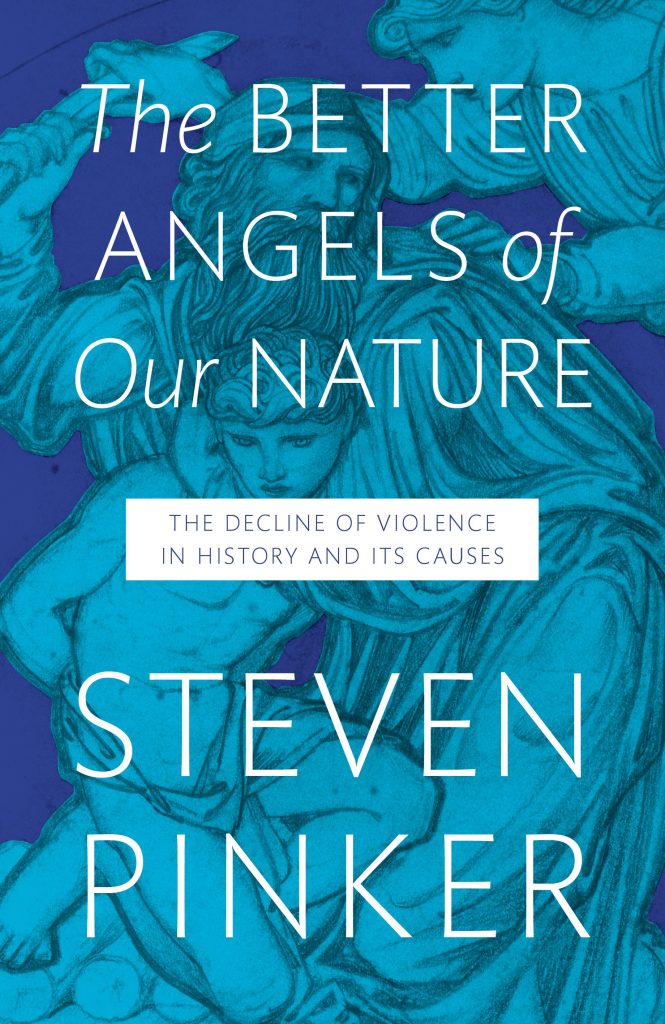“The better angels of our nature – The decline of violence in history and its causes” by Steven Pinker – book recommendation
By: Petra Šprem
“With violence, as with so many other concerns, human nature is the problem, but human nature is also the solution.” Steven Pinker
What if someone were to confront you with a provocative thesis that we live in the most peaceful time in the history of the human species? Would you find it shocking? Revealing? Comforting?

That is exactly what psychologist Steven Pinker did in his book “The better angels of our nature”. In six chapters, Pinker provides his readers with interesting facts and data which confirm his challenging thesis. The most intriguing part of this book are explanations on why violence has declined over the years? Pinker offers scientific facts to answer some of the eternal metaphysical questions like: are human beings essentially good or bad?, has the past century witnessed moral progress or a moral collapse?, what do we owe to the Enlightenment?, what is the link between encouraging women to vote and violence regression?, is there a link between the human rights movement and the campaign for animal rights?, why are homicide rates higher in the southerly states than in northern ones?, are aggressive tendencies heritable?, are we getting smarter?, is a smarter world a better world?. This book has answered so many questions for me, questions which all started by reading a simple newspaper article.
Not so long ago, North Sentinel tribe killed a young American missionary. I have to admit; I was pretty curious to find out more about the mysterious tribe that seemed so unduly violent. After reading an interview with an anthropologist Triloknath Pandit who dedicated his scientific career studying ‘untouched’ and isolated Sentinel tribes, he explained, to put it simple, that the tribe is not violent at all, that they are in fact very “peace-loving” people so he believes their fearsome reputation is simply unfair. Pandit explained that their violent response was a simple consequence of defending their own territory and getting rid of stubborn intruders. I must admit, my initial thought was: of course, they are violent because they are primitive. Their lack of civilised customs and sophisticated skills almost leaves them no choice but to use their own bare hands and defend what they worship – their territory. This thought led me to another conclusion. If violence equals barbaric and primitive, is our past more violent than our future? Has the civilisation upgrading led us to solve problems differently in more civilised manners? All this civilised heritage, culture ‘upgrading’ and all the knowledge we have gained until this day, must then create a less violent society. My curiosity has led me to the aforementioned book by Steven Pinker who actually confirmed some of my initial and, one might say, barely intuitive conclusions.
In his book, Pinker presents a large amount of data and statistical analysis that, he argues, demonstrate that violence has been in decline over millennia. Pinker begins with homicides. He presents a huge drop in one’s probability of being killed by someone else, as humanity passed from pre-state societies to those organised in cities and nations. He argues that in a pre-state tribe, your chance of a violent death averaged 15%. By contrast, even in pre-Columbian Mexico, a rather crude state structure, your chance was a mere 5%. Pinker reminds us of Thomas Hobbes and his Leviathan – an organized state power which was, therefore, one of few historical forces which have dropped down the violent-death rate. Giving the state power, a monopoly on violence people are forced to cohabitate and obey rules. Another historical force which encouraged declination of violence is commerce – the rise of “technological progress allowing the exchange of goods and services over longer distances and larger groups of trading partners,” so that “other people become more valuable alive than dead” and “are less likely to become targets of demonization and dehumanization.” To some, this might be surprising, but according to the author, we owe our civilisation upgrade to the women rights movement. Pinker offers a brilliant perspective on how that historical fight of feminism has offered human beings a chance to be less violent.
Pinker’s talent for telling stories supported with numerous scientific facts from different fields, surprising statistics and extraordinary trends, make this book a masterpiece that everyone interested in human nature (especially violence) should read.
Based on his impressive work, I could not help but ask Prof. Pinker on a short comment about using homicides as a proxy for violence. I quote his answer:

Counting homicides is indeed a crude way to measure violence. But the advantage is that we have commensurable data from many countries, decades, and centuries. The other obvious advantage is that homicides are less ambiguous than other categories of violence, like rape and assault; people are more likely to agree that a homicide has taken place, since a dead body is hard to argue with, so the counts are less dependent on reporting biases and subjective interpretations. My own policy in reporting and analyzing violence is to concentrate on homicide counts and victimization surveys — the latter do not depend on how willing victims are to go to the police, or how accurately the police report data.
As courts and lawyers have known for centuries, the difference between an assault and a homicide may depend on how close the nearest hospital is. Still, on average when there are more assaults there will be more homicides (since when there are no assaults there will be none). So homicide data, which are relatively unambiguous, can still be a good statistical proxy for violent assaults. A complication here of course is that the quality of emergency medical care has changed over the decades and varies from country to country. This pertains only to a proportion of potentially lethal assaults — not those where the victim would have survived no matter what, and not those where the victim would have died no matter what. This has to be taken into account, which is not easy. But because medical care can affect only proportions, whereas many trends and differences in violence span orders of magnitude (a 50-fold difference, for example), in many cases differences in the quality of medical cannot affect overall conclusions (e.g., the difference between Iceland and El Salvador, or New York in the early 1990s versus New York in the late 2000s.
One of the major questions in violence research is how strongly homicide is correlated with other forms of violence. For many kinds of violence the correlations seem to be strong. Though I don’t know the answer, I would guess that rates of rape, robbery, assault, kidnapping, and domestic violence, are higher in El Salvador than in Iceland. And we know for sure that in the US (for which we have victimization survey data) that they were much higher in the 1970s than in the 2000s, paralleling homicide rates (the correlations over years is often greater than .9, which is extraordinary). Likewise in differences among American states. I think there is a general phenomenon of greater or lesser lawlessness across years — in the 60s, 70s, and 80s, through the early 90s, all hell broke loose, with high rates of hate crimes, rapes, assaults, homicides, etc.; they all came down starting in 1992.
At the same time we know that some kinds of violence are less correlated with homicide, especially when they are a part of the local culture: domestic violence, for example, or beating of children by their parents, or infanticide.”
In a world of shocking headlines about terrorist acts, massive murders, civil wars, human trafficking and all these violent events that media serves us followed by the watchword “if it bleeds, it leads”, convincing people that nowadays societies are far more peaceful, less cruel and less violent than in the past, seems like a mission impossible (and Pinker is very well aware of that!). Although his thesis that violence has declined over the years is not entirely new and Pinker aligns with authors like Azar Gat and Robert Muchembled, he truly succeeded in this mission, supporting his hypothesis with convincing facts, shocking studies and great knowledge from the past. If you want to learn more on human’s nature, history, policy, anthropology, criminology, psychology and answer some of the deepest question about human beings, this brilliant book is the book for you. Well, at least this book will convince you that despite our history, we are indeed moving forward as a society and there is no scientific reason for nihilism.
For more on Steven Pinker visit: https://stevenpinker.com/
